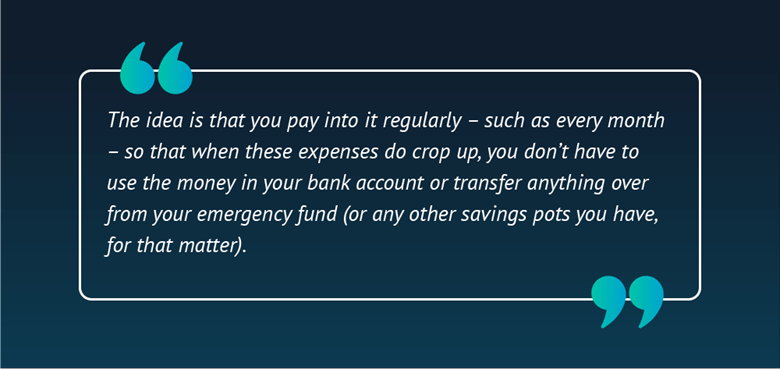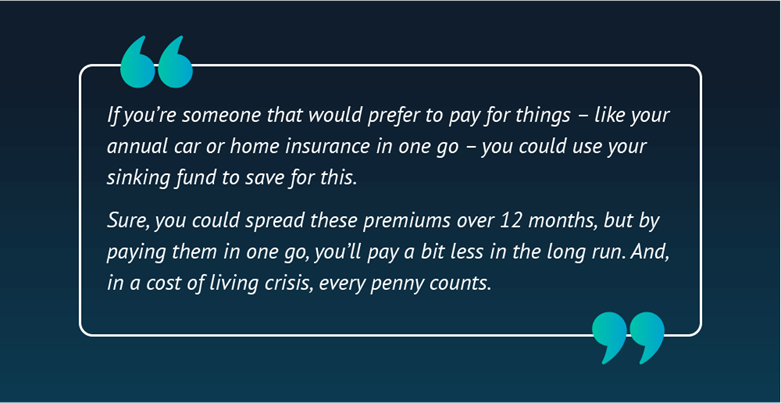Taking your car for an MOT and being told that you need to replace all four tyres. Checking your emails and seeing the reminder for your home insurance renewal. Being invited to a wedding — abroad.
These can all be costly situations that crop up from time to time — and are all ones likely to fill you with dread if you’re never prepared for them. But that’s precisely why ‘sinking funds’ exist.
If you haven’t heard of them, keep reading to find out what they are and how to build up your own.
What is a sinking fund?
Even though the thought of your money sinking doesn’t seem too positive, it could help take the pressure off irregular expenses or large one-off purchases. And that can only be a good thing, surely?
That’s because a sinking fund is a dedicated pot of cash to cover these types of costs. The idea is that you pay into it regularly – such as every month – so that when these expenses do crop up, you don’t have to use the money in your bank account or transfer anything over from your emergency fund (or any other savings pots you have, for that matter).
Fun fact: sinking funds were traditionally used by businesses and would involve putting money aside each month to pay off a debt!1

What could you use a sinking fund for?
Sinking funds are often used to pay for specific expenses, and there are many things that you might want to use yours to save for.
It could be for something that you know is going to happen, like an upcoming wedding you need to buy a gift and outfit for, or even a big holiday you’re planning to book next year.
And, if you’re someone that would prefer to pay for things – like your annual car or home insurance – in one go, you could use your sinking fund to save for this.
Sure, you could spread these premiums over 12 months, but by paying them in one go, you’ll pay a bit less in the long run. And, in a cost of living crisis, every penny counts.
You may even want to use it to put money away for costs you’re expecting to come up in the future (but hopefully won’t), such as your car or home needing repairs.

Where do you keep a sinking fund?
Ideally, this pot of cash won’t be kept in your regular bank account that you use for your day-to-day spending. It will also be separate from your emergency savings fund and any other savings pots you might have.
After all, if you simply kept this money back in your bank account, then you may be tempted to dip into it unnecessarily the next time ASOS emails you a discount code, or your friend invites you to an impromptu dinner (we’ve all been there, right?).
However, you will want your sinking fund to be in an account that’s easy to access for when you do need to put it to good use.
How much do you put in a sinking fund?
This will depend on what you’re saving for, and how much you can realistically afford to put in each month without struggling to get by.
So, before you decide, you’ll want to look at your outgoings (as well as how much you want to put into other savings pots each month) and go from there.
Is there anything else I can be doing?
Before sorting a sinking fund, you might want to build up some emergency savings in case you fall ill or lose your job. Typically, the amount in an emergency fund is the equivalent of around 3-6 months’ worth of outgoings.
Once that’s in place, something else you might want to consider is having some longer-term savings and investments, which could give you an opportunity to build your wealth over time.
However, unlike your emergency savings or sinking fund (that you may need to dip into in the near future), these are typically intended to be left for an extended amount of time so that they can gain interest (in the case of cash savings) or generate returns (if you hold investments).
Please remember the value of your investments can go down as well as up, and you could get back less than invested.
Wealthify does not provide financial advice. Seek financial advice if you are unsure about investing.
The tax treatment depends on your individual circumstances, and it may be subject to change in the future.
References:



